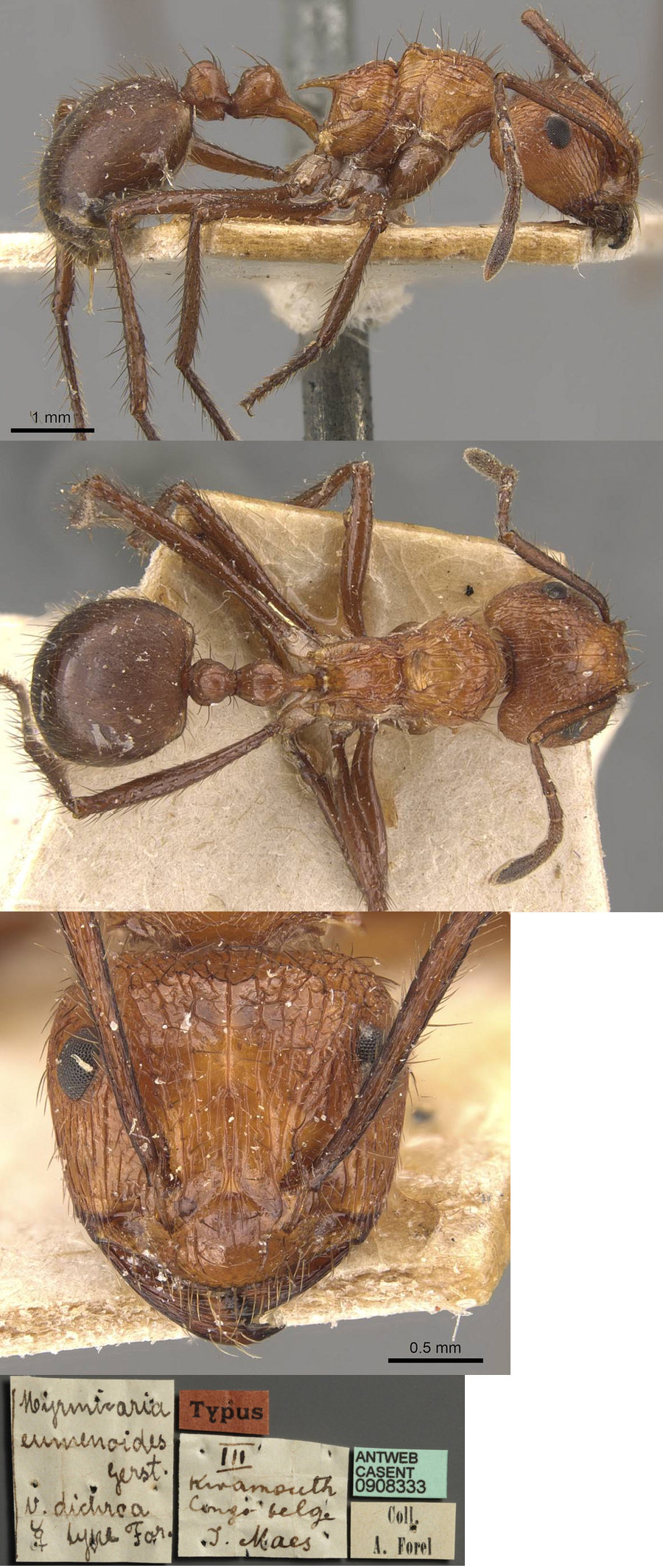Myrmicaria taeniata Santschi - new status
  Type location Zaïre (Myrmicaria natalensis Sm. v. taeniata n. var. Santschi, 1930d:
269, worker) from Kasongo, Dr Stoppers - see below. Type location Zaïre (Myrmicaria natalensis Sm. v. taeniata n. var. Santschi, 1930d:
269, worker) from Kasongo, Dr Stoppers - see below.
The original description of the worker (my translation)
had: brown ochre
or pale reddish, the vertex and the gaster darker brown, the borders of
the tergites edged with brown. Frons more densely striate, almost as eumenoides. Nodes and gaster
smooth. Form as M. irregularis
Sants., but with the petiole as in eumenoides.
It is a transitional form. Note: location given as "Congo Belge:
Katanga (Dr Stappers)".
The distinguishing features that readily separate it
from the accepted M. natalensis
workers are: the
greater number of fine longitudinal striations on the face; the
relatively pale scapes with almost no longitudinal striae; the
longitudinal striae on the promesonotum reaching right to the anterior;
the fine but clear spiculate sculpture on the base of the gaster
(contrars to Santschi;s statement).
The "dichroa" worker, also
from Zaïre, shares all those features; as do the fresh workers
from
Gabon and Cameroun. |
 The photomontage of
the apparently unpublished dichroa
type worker
is
collated from http://www.antweb.org/specimen.do?name=casent0908333.
Forel (1913h) listed a finding of ants by Dr. J Maes at Kwamouth, that
was of Paratrechina longicornis
(as Prenolepis, p 354). In the same paper appear finsings of Myrmicaria eumenoides, congolensis and opaciventris,
none were by Dr Maes or from Kwamouth. Maes (as Moes) is mentioned also
in Santschi (1930a) xii.1913 at Oshwe; and in Santschi (1935a). The photomontage of
the apparently unpublished dichroa
type worker
is
collated from http://www.antweb.org/specimen.do?name=casent0908333.
Forel (1913h) listed a finding of ants by Dr. J Maes at Kwamouth, that
was of Paratrechina longicornis
(as Prenolepis, p 354). In the same paper appear finsings of Myrmicaria eumenoides, congolensis and opaciventris,
none were by Dr Maes or from Kwamouth. Maes (as Moes) is mentioned also
in Santschi (1930a) xii.1913 at Oshwe; and in Santschi (1935a).
|
 Specimen
collected in the extreme southeast of Cameroun - McKey Wolbachia
project) - Cameroon 122 from Kouedjina
(3°55' N, 13°45' E, altitude 692 m), 20 April 2001, noted simply as
terricolous ants. Appears identical to taeniata. Specimen
collected in the extreme southeast of Cameroun - McKey Wolbachia
project) - Cameroon 122 from Kouedjina
(3°55' N, 13°45' E, altitude 692 m), 20 April 2001, noted simply as
terricolous ants. Appears identical to taeniata.
|
With the foregoing separation of taeniata as a
species from Congo, Gabon and Cameroun, I suspects the following all
also are of the newly defined species.
Wheeler (1922) listed findings (as eumenoides)
which include Cameroun (Bibundi, by Tessmann).
Bernard (1952) reported the finding of numerous workers
from N'Zo and Yanlé in Guinea; noting it as the most common
genus member in all of tropical Africa.
It is primarily a species of the Sudan savannah
according to Lévieux, who made extensive studies of its behaviour in Ivory
Coast (as eumenoides, Lévieux, 1983a); at Lamto and
Ferkéssédougou. He described it as more common than Myrmicaria
striata, with a surface-foraging habit and nests with distinct
crater openings. Nests tend to be clumped. The colony size was
18,000-22,000 individuals, the latter being in a colony more than three
years old. Foraging in the Guinea savannah was over some 12-15 m² and
in the Sudan savannah over a much larger 110 m², up to 11 m from the
nest. The diet consists of 95% arthropods (insects 60-80%, especially
other ants and termites, both adults and larvae. It collects honeydew
from Aleyrodoidea, whiteflies, living on grasses or on trees, up to
about 5 m. Activity tends to be bimodal with morning and late afternoon
peaks.
Interestingly, Wheeler (1922) related its habits at some
length, noting that Arnold described it as never tending aphids,
membracids or lepidopterous larvae; the nesting habits were. however,
the same as those described by Lévieux.
The poison gland secretions have been discussed by
Bradshaw & Howse (1984). In brief, the secretions may be used
sparingly, to label potential prey items, or in larger quantities as an
alarm signal to stimulate an aggressive defence response. The chemicals
used are monoterpene hydrocarbons, apparently a somewhat unique
characteristic of the genus.
|